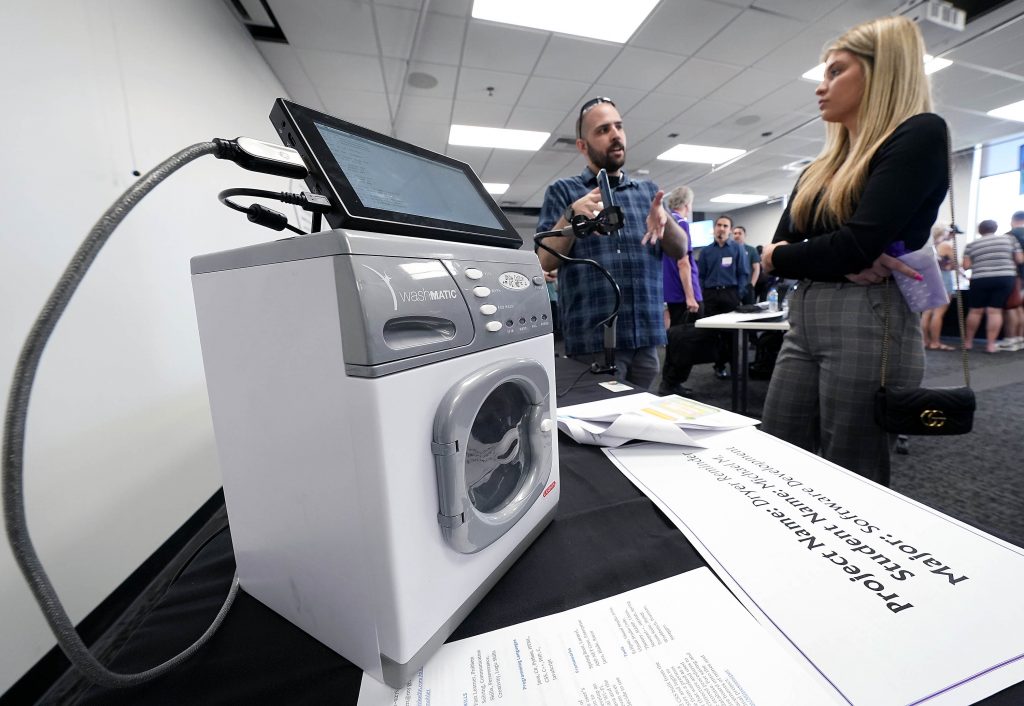
Michael Mohler presents his project, Dryer Reminder, at Thursday’s Technology Capstone Showcase in the Cyber Center of Excellence.
Story by Lana Sweeten-Shults
Photos by Ralph Freso
GCU News Bureau
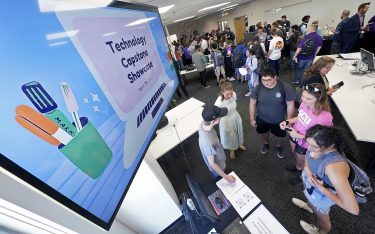
Projects at the showcase ranged from a campus golf cart tracker to a student nutrition monitor web app to a voice-controlled music player called PiTunes.
Michael Mohler: Master multitasker.
It’s why he doesn’t always hear the alarm on his dryer as he piddles away in faraway rooms in his house.
“If you’re like me, you’re far enough away from the dryer in your home, and if you’ve got a bunch of other things going on, it’s nice to get a notification to know when the dryer is done,” said the Grand Canyon University software development student, who took an everyday conundrum from home and, like the more than 100 students showcasing their work at Thursday’s Technology Capstone Showcase, got his hands dirty to try to solve his laundry quandary.
“I always wanted that solution, and anytime I was doing laundry, I always thought to myself, ‘I hate how I have to keep checking the dryer. I wish someone would make something.’ I guess that someone had to be me,” Mohler said with a smile of his project, Dryer Reminder.
What Mohler did was take a credit card-size computer called a raspberry pi and placed on it an accelerometer, which measures the acceleration of motion of a structure. He then used an Android application to communicate with the raspberry pi. When the accelerometer detects a lack of motion on the dryer, it sends a notification to the user’s phone so that person knows the dryer is done.
Mohler uses Dryer Reminder at home all the time.
“I literally bring my device out and my family’s like, ‘Oh, are you testing your device again?’”
Nope, he tells them, he just likes using it.
“I LOVE it. I literally use it every day.”
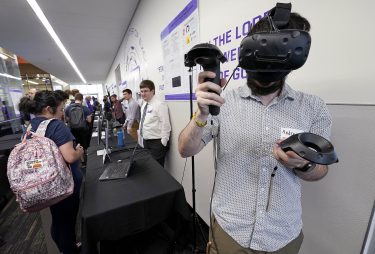
Computer science senior Andrew Goodman demonstrates his Virtual Reality Operating System (VROS).
It wasn’t the only problem solved at the annual Technology Capstone Showcase, when the College of Science, Engineering and Technology’s students, after months of coding and testing, creating CAPTCHAs, web developing and, throwing a little engineering in there for good measure, looked up from their computers and presented their college career-ending projects — their exit ticket of sorts for graduation, just two weeks away.
Technology students showcased almost 50 projects with nary room to move in the Technology Building’s packed Cyber Center of Excellence, with tables of students spilling into the adjacent hallway to share those projects with the campus community and with members of industry, too.
Guests viewed everything from the Dryer Reminder to a live, interactive report on the U.S. government’s spending and budgets, to a voice-controlled music player called PiTunes (it also uses a raspberry pi), to virtual reality simulations that provide therapy to a GCU student nutrition monitor web app.
“It’s an incredible variety of projects, which is wonderful, because it (the technology capstone process) really allows students to choose what they want to focus on and take that deep dive into it,” said Assistant Dean of Technology Dr. Brandy Harris. “Their enthusiasm … it’s wonderful, palpable, you can walk around and feel it.”
Added Dr. Pam Rowland, Associate Dean of Computer Sciences and Technology, “What impressed me the most was the creativity and how students took what they’ve learned, and they solved a real-world problem, oftentimes in groups, where they worked together as a team to really create something valuable that they could contribute to the industry,”
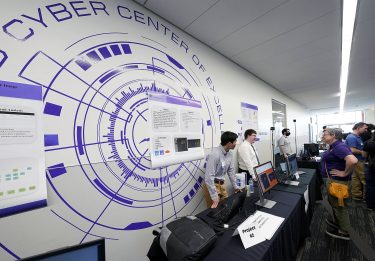
Computer science, computer programming, IT, cybersecurity and software development majors showcased their work.
The problem the Robot XD team worked on was how to get the world of robotics into the hands of regular people who aren’t necessarily computer-science savvy and who might not have a lot of money to spend on technology.
The team not only created a functional, artificially intelligent robot with the ability to hear, speak and move freely, but they also developed an open-source robot kit so users can imitate what the team has created.
Robot XD team member Jonathan Lopez Valdez said, “It’s very easy to spend thousands of dollars on a robot. A robot like this could run you $3,000. But we can do it for $600. It just shows that you are able to do it without necessarily having a big pocketbook.”
Lopez Valdez has been working with team members Kevin Ahlstrom, Luis Pena Espinoza and Abdulmalik Bawa since last summer to create the robot.
“We’re computer science majors, but a lot of the work that went into it is not necessarily related to computer science,” Lopez Valdez said. “A lot of the wiring, those go with engineering.”
“So you learned a lot?” an attendee asked.
“Putting it lightly, yeah,” Lopez Valdez said.
The IT/cybersecurity Stratis team created a web-based prototype in which the students want to empower photographers to share their work in a secure way, with a lot of attention paid to copyright.
“How many times have you been on Instagram and saw a picture and then see that same picture somewhere else?” asked Orion Zakas, who worked with IT/cyber classmates Andrew Penrod, Emily Homes, Jesse Rittenhouse, Jessica Varea, Nissi Enriquez and Preston Sanders on the project.
“You don’t really know whose picture that is, so our goal is to protect that and ensure people can post their pictures and have a profile with all of their pictures to promote their business,” Zakas said.
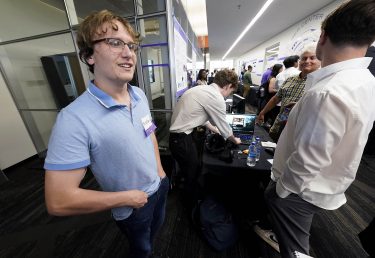
Tristan Janisse and his team created a virtual piano that uses software to search websites for song files.
A group of computer science majors fashioned a virtual piano that can play a seemingly endless number of songs. The software searches websites for a song file and loads it into a cross-platform game engine called Unity, which then prompts the virtual piano to play the song.
Not that the team didn’t hit some sour notes.
Tristan Janisse said the team wanted to incorporate tactile gloves so users could get the feel of playing a real piano.
“But we ran into constraints and issues with that, so instead we decided to create a player piano in virtual reality,” said Janisse, who worked with fellow students Ryan Jones, Tyler Williams and Stephen Blake Sanders.
Three of them play instruments, and they ultimately want to launch the software on an actual player piano.
“In the summer, we’re actually going to,” said Jones. “The software would all be the same. Instead of a virtual key to press, you would have some robotics do it for you.”
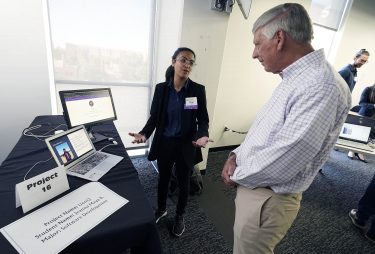
Jeanna Maye Benitez explains her LionQ app to GCU President Brian Mueller.
Software development senior Jeanna Maye Benitez used Java, Spring Boot, MySQL, Azure, WebSocket and SockJS to create a social hub dubbed LionQ, which is named after one of her favorite films, “The Lion King” (the “Q” stands for “queen”).
On the web application, users can interact with one another via messaging and can create, update, list, search and delete posts. She was inspired by Facebook, she said, to create LionQ.
But, “I kind of wanted to make something that’s more positive,” Benitez said, and shared that idea, a bit nervously, with GCU President Brian Mueller, one of the guests at the event. “I wanted to make something that helps communities.”
If she had more time, she said she would be more specific in her audience, such as making LionQ for educational institutions so “they can help each other out and just connect with each other.”
Benitez, who spent the fall semester mapping out LionQ and the spring semester building it, said of tackling her project, “It’s a lot of work, but it pays off.”
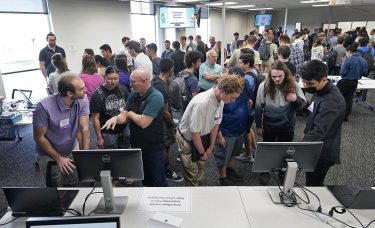
More than 100 GCU technology students shared almost 50 capstone projects at the packed Cyber Center of Excellence.
The packed capstone showcase was a welcome site for the college, which presented the event virtually the previous two years because of COVID-19. The size of the event, organized in partnership with GCU Strategic Employer Initiatives and Internships, was proof of the technology program’s growth.
“When I came in (in 2015), it was very much the beginning, and I’d have five students in a class,” said Lydia Fritz, a computer science/computer programming assistant professor. “Now I have multiple sections, so it’s grown, and the students keep getting better” — students industry is looking to hire.
“Our faculty has done an amazing job with making relationships with industry partners,” said Rowland, in her first year as associate dean. “Some of these capstone projects come from industry partners. All of these relationships that have been built over these years, prior to my coming to GCU, have developed this program.”
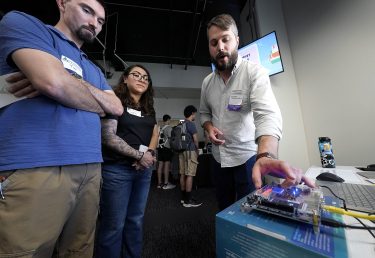
Salvatore Parascandola (right) explains his “Rich Purnell Maneuver” circuit board clock to Prime Solutions Group software engineer Tim Wiley (left) and human resources associate/recruiter Jackie Tautimez (center).
Human resources associate/recruiter Jackie Tautimez of Prime Solutions Group experienced the Technology Capstone Showcase for the first time in person after two years of virtual sessions.
“These are very cool projects and very smart students,” said Tautimez, whose company just hired four GCU students as interns and has hired past interns from the University as entry-level software engineers.
GCU students will be happy to keep getting their hands dirty for those kinds of prospects.
Senior writer Lana Sweeten-Shults can be reach at [email protected] or 602-639-7901.
***
Related content:
GCU Today: Panelists from Deloitte, General Motors talk tech
GCU Today: Coding with My Girls breaks down cyber barriers
GCU Today: STEM savvy launched at MESA Regional Design Day
